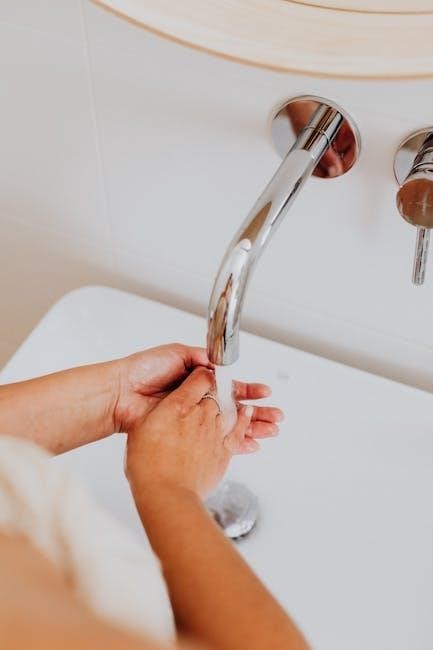A manual water pump is a versatile, non-electric device designed to extract water from sources like wells, tanks, or flooded areas using human effort. It ensures reliable water supply in various settings, offering simplicity, durability, and ease of operation without electricity, making it essential for residential, agricultural, marine, and emergency applications.

Applications of Manual Water Pumps
Manual water pumps are versatile tools essential for domestic use, irrigation, marine needs, and emergency water extraction, ensuring a reliable and portable water supply solution across various settings.
Residential Use
Manual water pumps are ideal for household needs, providing water for gardens, irrigation, and domestic use. They are easy to install and operate without electricity, making them reliable during power outages. Suitable for extracting water from wells or tanks, they ensure a steady supply for daily tasks. Regular inspection and maintenance are essential to ensure optimal performance and longevity.
Agricultural and Irrigation Purposes
Manual water pumps are essential for agricultural and irrigation needs, providing a reliable and cost-effective solution for watering crops and livestock. They are ideal for rural areas with limited access to electricity, ensuring consistent water supply. Durable and easy to maintain, these pumps support small-scale farming and irrigation systems, contributing to agricultural productivity and sustainability in remote regions.
Marine and Boating Requirements
Manual water pumps are crucial for marine applications, particularly for bilge pumping to remove water from boats. Regulations require vessels between 9 and 12 meters to carry a manual pump, ensuring safety and compliance. The pump must have sufficient capacity and hose length to discharge water effectively over the boat’s side, meeting marine safety standards and preventing water accumulation that could lead to capsizing.
Emergency and Flood Relief
Manual water pumps are essential for emergency and flood relief scenarios, providing a reliable means to extract water from flooded areas. They are designed to operate without electricity, making them ideal for disaster situations. Durable and easy to use, these pumps ensure efficient water removal, helping to prevent damage and restore safety. Regular inspection and maintenance are critical for optimal performance during emergencies.
Design and Construction Requirements
Manual water pumps must be constructed from durable, corrosion-resistant materials to ensure longevity. The design should prioritize stability, ease of operation, and efficient water extraction, with minimal moving parts.
Types of Manual Water Pumps
Manual water pumps are available in various types, including diaphragm, piston, and centrifugal designs. Diaphragm pumps are durable and ideal for corrosive environments, while piston pumps offer high pressure for deep wells. Centrifugal pumps are suited for high flow rates and ease of operation. Each type caters to specific needs, ensuring efficient water extraction in diverse scenarios.
Materials and Build Quality
Manual water pumps are typically constructed from durable materials like stainless steel, brass, or PVC to ensure longevity and resistance to corrosion. The build quality must withstand frequent use and harsh environments, with components designed for ease of maintenance and replacement. Durable materials ensure reliability and efficiency in water extraction, making them suitable for various applications.
Key Components of a Manual Pump
A manual water pump consists of essential components, including a piston, cylinder, handle, suction valve, and discharge valve. These parts work together to create suction and propel water through the system. The handle provides the mechanical force, while valves ensure unidirectional flow, making the pump efficient and effective in extracting water from various sources.

Installation and Safety Guidelines
Ensure the pump is stable and immobile during operation, with proper grounding and electrical connections to prevent hazards. Regular inspections are crucial for safe functionality.
Location and Stability
Manual water pumps require a stable, flat surface for optimal performance. A concrete or sturdy metal base is recommended to prevent movement during operation. Ensure the pump is securely fastened to avoid displacement caused by suction hose tension. Regularly inspect the suction hose for damage and ensure it is properly anchored to maintain stability and efficiency.
Electrical and Grounding Requirements
Manual water pumps typically do not require electricity, but if automated, ensure the system is connected to a 220-230V, 50Hz grounded socket. Proper grounding prevents electrical hazards and ensures safe operation. The installation must comply with local electrical codes, and the differential switch should not exceed 30mA. Regularly inspect connections to maintain safety and efficiency.
Operational Stability and Safety
Ensure the pump remains stable during use to prevent movement that could cause damage or accidents. Check for excessive noise in bearings and inspect all components for wear. Regular maintenance ensures optimal performance and safety. Proper operation prevents misuse, such as pumping corrosive or flammable liquids, which can compromise the pump’s integrity and pose hazards. Stability is key for reliable function.
Performance and Capacity Requirements
Manual water pumps must deliver consistent flow rates and pressure to meet specific application needs. The pump’s capacity should match the required water volume efficiently, ensuring optimal performance.
Flow Rate and Pressure
Manual water pumps must deliver adequate flow rates and pressure to meet specific requirements. Flow rate measures the volume of water pumped per minute, while pressure ensures water reaches desired heights or distances. Proper suction depth and discharge hose length significantly impact performance. Selecting a pump with suitable flow rate and pressure ensures efficient water supply for residential, agricultural, or marine applications.
Suitable Tubing and Hose Specifications
Manual water pumps require tubing and hoses with specific diameters and lengths to ensure efficient water flow. A 25mm diameter tubing, 1-2 meters long, is often recommended. The hose must be durable, resistant to corrosion, and compatible with water types. For marine use, hoses should reach from the bilge to over the boat’s side, ensuring proper water discharge without compromising performance or safety.

Materials and Durability
Manual water pumps are typically constructed from durable materials like metal or high-quality plastics. They must be resistant to corrosion and compatible with various water types to ensure longevity and reliable performance.
Corrosion Resistance
Manual water pumps must exhibit high corrosion resistance to withstand harsh environments; Materials like stainless steel or coated metals are ideal, ensuring durability against saltwater, chemicals, and abrasive particles. This prevents premature wear and extends pump lifespan, especially in marine or agricultural settings where exposure to corrosive elements is common.
Compatibility with Water Types
Manual water pumps must be compatible with various water types, including fresh, brackish, and saltwater. Proper material selection ensures resistance to corrosion and mineral buildup, maintaining efficiency. They should not handle hazardous liquids like sewage, oil, or chemicals without specialized designs, ensuring safe and effective operation across diverse water conditions and applications.
Operation and Maintenance
Regular inspection of pump condition and operation is essential. Check for cleanliness, appearance, and any operational deficiencies. Ensure all bearings are free from excessive noise and wear, guaranteeing smooth and efficient functionality over time.
Regular Inspection and Maintenance
Regular inspection ensures optimal performance and longevity. Check pump components for wear, corrosion, or blockages. Ensure all moving parts are lubricated and functioning smoothly. Inspect hoses and connections for damage or leaks. Replace consumable parts like seals or gaskets as needed. Clean the pump periodically to prevent debris buildup and maintain efficiency. Schedule maintenance based on usage and environmental conditions to prevent unexpected failures.
Replacing Consumable Parts
Regularly replace seals, gaskets, and valves to prevent leaks and maintain efficiency. Follow manufacturer guidelines for part replacement to ensure compatibility and performance. Inspect and replace worn or damaged components promptly to avoid system failure. Keep spare parts on hand for quick replacements, minimizing downtime. Proper replacement ensures reliable operation and extends the pump’s lifespan. Always refer to the user manual for specific instructions.
Regulations and Standards
Manual water pumps must comply with marine safety regulations, fire safety standards, and electrical grounding requirements. Ensure proper installation and grounding contacts for safe operation and compliance with local laws.
Marine Safety Regulations
Manual water pumps on marine vessels must meet specific safety standards. Boats between 9 and 12 meters require a manual water pump onboard, while smaller vessels may use either a pump or bailer. Bailers must hold at least 750ml of water and have a minimum opening of 65cm. Pumps should be durable, made of metal or approved materials, and capable of efficient water removal to ensure vessel safety and compliance with regulations.
Fire Safety and Compliance
Manual water pumps must comply with fire safety regulations, ensuring reliable operation in emergencies. Fire pumps require minimum rated capacities, specific valve installations on suction and discharge pipes, and proper electrical grounding. The installation must include a differential switch not exceeding 30mA and secure connections. Regular inspections are mandatory to maintain compliance with fire safety codes and ensure efficient performance during critical situations.

Troubleshooting Common Issues
Regular inspection ensures functionality, addressing issues like excessive noise from bearings or operational deficiencies. Replacing consumable parts and ensuring proper maintenance are essential for reliable performance and longevity.
Identifying Operational Deficiencies
Regular inspection is crucial to identify operational deficiencies. Check for excessive noise from bearings, unusual vibrations, or reduced water flow. Ensure all components are clean and functioning properly. Inspect the pump’s condition, including wear on moving parts, and address any issues promptly to maintain efficiency and prevent further damage or malfunction during use.
Addressing Noise and Vibration
To minimize noise and vibration, ensure the pump is installed on a stable, level surface and secure all components tightly. Regular lubrication of moving parts and balancing the pump can reduce operational noise. Inspect for loose connections or worn-out components and replace them promptly. Proper grounding and alignment of the pump also help in reducing vibrations and ensuring smooth operation.

Environmental Considerations
Manual water pumps must be designed for water efficiency and environmental compliance, minimizing waste and avoiding contamination. They should not discharge prohibited substances, ensuring sustainable and eco-friendly operation in all settings.
Water Efficiency
Manual water pumps must ensure water efficiency by minimizing waste and optimizing flow. They should be designed to handle water without contamination, ensuring sustainable use in various applications while adhering to environmental safety standards.
Restrictions on Usage
Manual water pumps must not be used for saltwater, sewage, flammable, or corrosive liquids. They are designed for clean water applications only, ensuring safe and reliable operation across residential, agricultural, and marine settings while complying with environmental and safety regulations.
